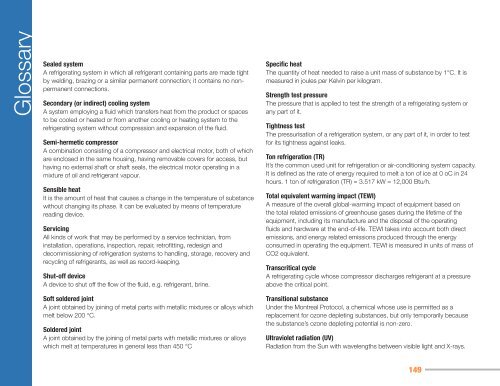Manual for Refrigeration Servicing Technicians - UNEP - Division of ...
Manual for Refrigeration Servicing Technicians - UNEP - Division of ...
Manual for Refrigeration Servicing Technicians - UNEP - Division of ...
Create successful ePaper yourself
Turn your PDF publications into a flip-book with our unique Google optimized e-Paper software.
Glossary<br />
Sealed system<br />
A refrigerating system in which all refrigerant containing parts are made tight<br />
by welding, brazing or a similar permanent connection; it contains no nonpermanent<br />
connections.<br />
Secondary (or indirect) cooling system<br />
A system employing a fluid which transfers heat from the product or spaces<br />
to be cooled or heated or from another cooling or heating system to the<br />
refrigerating system without compression and expansion <strong>of</strong> the fluid.<br />
Semi-hermetic compressor<br />
A combination consisting <strong>of</strong> a compressor and electrical motor, both <strong>of</strong> which<br />
are enclosed in the same housing, having removable covers <strong>for</strong> access, but<br />
having no external shaft or shaft seals, the electrical motor operating in a<br />
mixture <strong>of</strong> oil and refrigerant vapour.<br />
Sensible heat<br />
It is the amount <strong>of</strong> heat that causes a change in the temperature <strong>of</strong> substance<br />
without changing its phase. It can be evaluated by means <strong>of</strong> temperature<br />
reading device.<br />
<strong>Servicing</strong><br />
All kinds <strong>of</strong> work that may be per<strong>for</strong>med by a service technician, from<br />
installation, operations, inspection, repair, retr<strong>of</strong>itting, redesign and<br />
decommissioning <strong>of</strong> refrigeration systems to handling, storage, recovery and<br />
recycling <strong>of</strong> refrigerants, as well as record-keeping.<br />
Shut-<strong>of</strong>f device<br />
A device to shut <strong>of</strong>f the flow <strong>of</strong> the fluid, e.g. refrigerant, brine.<br />
S<strong>of</strong>t soldered joint<br />
A joint obtained by joining <strong>of</strong> metal parts with metallic mixtures or alloys which<br />
melt below 200 °C.<br />
Soldered joint<br />
A joint obtained by the joining <strong>of</strong> metal parts with metallic mixtures or alloys<br />
which melt at temperatures in general less than 450 °C<br />
Specific heat<br />
The quantity <strong>of</strong> heat needed to raise a unit mass <strong>of</strong> substance by 1°C. It is<br />
measured in joules per Kelvin per kilogram.<br />
Strength test pressure<br />
The pressure that is applied to test the strength <strong>of</strong> a refrigerating system or<br />
any part <strong>of</strong> it.<br />
Tightness test<br />
The pressurisation <strong>of</strong> a refrigeration system, or any part <strong>of</strong> it, in order to test<br />
<strong>for</strong> its tightness against leaks.<br />
Ton refrigeration (TR)<br />
It’s the common used unit <strong>for</strong> refrigeration or air-conditioning system capacity.<br />
It is defined as the rate <strong>of</strong> energy required to melt a ton <strong>of</strong> ice at 0 oC in 24<br />
hours. 1 ton <strong>of</strong> refrigeration (TR) = 3.517 kW = 12,000 Btu/h.<br />
Total equivalent warming impact (TEWI)<br />
A measure <strong>of</strong> the overall global-warming impact <strong>of</strong> equipment based on<br />
the total related emissions <strong>of</strong> greenhouse gases during the lifetime <strong>of</strong> the<br />
equipment, including its manufacture and the disposal <strong>of</strong> the operating<br />
fluids and hardware at the end-<strong>of</strong>-life. TEWI takes into account both direct<br />
emissions, and energy related emissions produced through the energy<br />
consumed in operating the equipment. TEWI is measured in units <strong>of</strong> mass <strong>of</strong><br />
CO2 equivalent.<br />
Transcritical cycle<br />
A refrigerating cycle whose compressor discharges refrigerant at a pressure<br />
above the critical point.<br />
Transitional substance<br />
Under the Montreal Protocol, a chemical whose use is permitted as a<br />
replacement <strong>for</strong> ozone depleting substances, but only temporarily because<br />
the substance’s ozone depleting potential is non-zero.<br />
Ultraviolet radiation (UV)<br />
Radiation from the Sun with wavelengths between visible light and X-rays.<br />
149

















